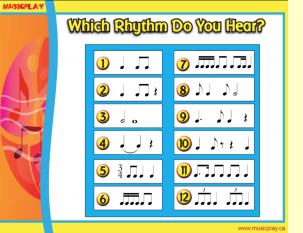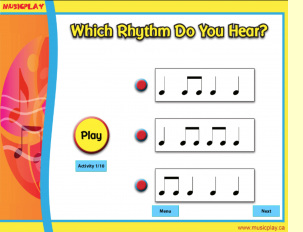As we approach the end of the school year for some of our American friends, I wanted to share some easy and quick ways to assess the students’ ability to read and write rhythms.
1. Flashcard Attendance ~ Rhythm Reading Assessment
In the Musicplay teacher’s guides I sometimes suggest starting your class with flashcard attendance. We don’t always have to take attendance, but in schools where you do, make taking the attendance into an opportunity for a quick evaluation.
In flashcard attendance, I would take the pile of cardstock flashcards that the students were working on. I’d call a child’s name, hold up the flashcard and the child would read it.
4 – student accurately and fluently claps and says the pattern
3 – student is mostly accurate and mostly fluent in clapping and saying the pattern
2 – student is somewhat accurate and somewhat fluent in clapping and saying the pattern
1 – student has many inaccuracies clapping and saying the pattern and is not able to keep a steady beat
Themes & Variations publishes a set of 100 rhythm flashcards that are printed on colored cardstock. The color coding indicates the patterns included in the set and helps you to quickly find the set that each class is working on.
Purchase our great set of Flashcards
TeachersPayTeachers – Rhythm Flashcards
Order Cardstock Flashcards from Musicplay Canada
Order Cardstock Flashcards – USA
At www.musicplayonline.com, we’ve taken the flashcards and made this into a very quick and easy to use movie – just press play. There are 25-35 patterns in each set. There are fewer patterns for very easy sets as younger classes are usually smaller (we hope!) and more patterns in the harder or longer sets for your older students. In the easier sets, we’ve given you both 4 beat assessments and 8 beat assessments. You can choose the set that you want to assess.
The Rhythm Practice Menu is on the left menu (on computers). Select Rhythm Practice, then select Assessments. There are 15 levels for rhythm assessments from K all the way to Grade 8.
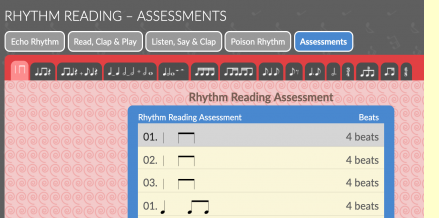
Rhythm Reading Assessment at www.musicplayonline.com. To make this really easy, line your students up or seat them in class list order. Student 1 on your class list will read the first rhythm pattern, then student 2, etc.
For the first 2 patterns, the voice says “ready go.” After the first 2 patterns, “ready go” is replaced with “click click.” There is a 2 beat pause at the end of the pattern, where you can say the name of the next student. If your students need the “ready go” prompt you can say it with the clicks.
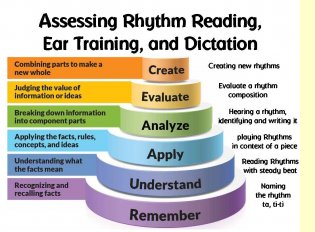
This graphic illustrates where I think that rhythm assessments fall on Blooms taxonomy. Naming the rhythm as ta or ti-ti would be remembering. Reading rhythms with a steady beat would fall into understanding/applying. When you do rhythm dictation, this is even higher up the taxonomy – this is applying/evaluating. When you have students create their own rhythm compositions, you’re at the highest level.
Rhythm Dictation Assessments
Scroll past the Rhythm Reading Assessments in the Assessment Section to Rhythm Dictation. A PDF is given with the answer key, and it has a printable 4 Beat Rhythm Dictation worksheet for students to complete.
(If you want to save paper, use recycled paper and have students write their names at the top and number from 1-5.)
Play the question and pause. Drag the video back to repeat, or clap it again for students if they need to hear it a second time. Five questions are given. The Answers follow. I like to have students exchange papers and grade them in class, then I check them over and enter them into my gradebook.
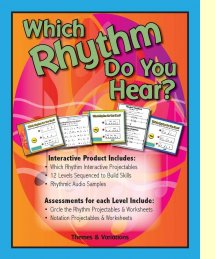 Which Rhythm Do You Hear?
Which Rhythm Do You Hear? Another tool that’s available online and as a print product is Which Rhythm Do You Hear?
There are many levels to select from. Choose your level, and you have 10 questions. Press “play” and students choose the rhythm that they heard. If you have a SMART Board, students can select the answers on the board. Or you could have them hold up 1, 2 or 3 fingers to indicate which answer they choose.
If you want to use these as your assessment, Just press play, allow students to write down their answer, then go onto the next question without showing the answer. I’ve found 5 questions are enough for a good assessment – I don’t need to do all 10. There are printable answer sheets in the print product.
Follow #musicplayonline on instagram, twitter, Pinterest

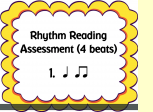
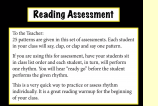
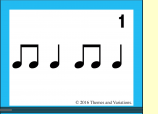
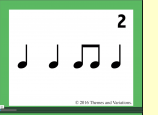
 This graphic illustrates where I think that rhythm assessments fall on Blooms taxonomy. Naming the rhythm as ta or ti-ti would be remembering. Reading rhythms with a steady beat would fall into understanding/applying. When you do rhythm dictation, this is even higher up the taxonomy – this is applying/evaluating. When you have students create their own rhythm compositions, you’re at the highest level.
This graphic illustrates where I think that rhythm assessments fall on Blooms taxonomy. Naming the rhythm as ta or ti-ti would be remembering. Reading rhythms with a steady beat would fall into understanding/applying. When you do rhythm dictation, this is even higher up the taxonomy – this is applying/evaluating. When you have students create their own rhythm compositions, you’re at the highest level.
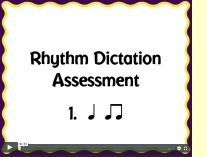
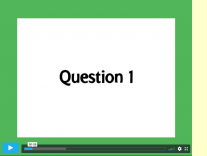
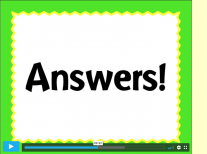
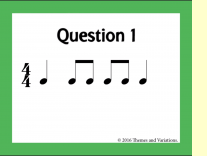
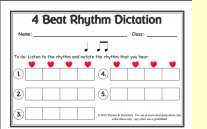
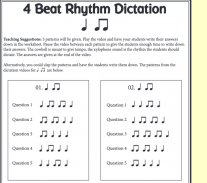
 Which Rhythm Do You Hear? Another tool that’s available online and as a print product is Which Rhythm Do You Hear?
Which Rhythm Do You Hear? Another tool that’s available online and as a print product is Which Rhythm Do You Hear?
